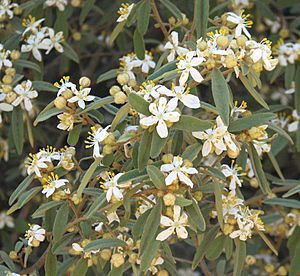Asterolasia hexapetala facts for kids
Quick facts for kids Asterolasia hexapetala |
|
|---|---|
 |
|
| In Maranoa Gardens | |
| Scientific classification | |
| Genus: |
Asterolasia
|
| Species: |
hexapetala
|
| Synonyms | |
|
|
Asterolasia hexapetala is a type of shrub that grows upright and spreads out. It is special because it only grows in the Warrumbungles area of New South Wales, Australia. This plant has leaves that are shaped like long ovals. These leaves have tiny, star-shaped hairs, especially on their underside. Its flowers are white and grow in small groups. You can find them where leaves meet the stem or at the ends of branches. The back of the petals on these flowers is covered with thick, woolly, star-shaped hairs that can be white, yellow, or brown.
Contents
What Does Asterolasia hexapetala Look Like?
Asterolasia hexapetala is a shrub that stands tall and spreads wide. It usually grows up to about 3 meters (10 feet) high.
Leaves and Hairs
The leaves of this plant are shaped like long ovals. They are usually between 30 and 60 millimeters (1.2 to 2.4 inches) long. They are also about 5 to 15 millimeters (0.2 to 0.6 inches) wide. Each leaf sits on a small stalk, called a petiole, which is 5 to 15 millimeters long.
The leaves are covered with tiny, star-shaped hairs. These hairs can be white or brownish. They are often softer and thicker on the underside of the leaf.
Flowers and Petals
The flowers grow in small clusters. You can find these clusters where the leaves join the stem. They also grow at the very ends of the branches. Each flower has its own small stalk, called a pedicel, which is 5 to 20 millimeters long.
Each flower has five petals. These petals are usually white or light yellow. They are about 7 to 9 millimeters long. The back of each petal is covered with thick, woolly, star-shaped hairs. These hairs can be white, yellow, or brown. This plant blooms in the spring.
How Was Asterolasia hexapetala Named?
This plant was first officially described in 1825. A French botanist named Antoine Laurent de Jussieu gave it the name Phebalium hexapetalum.
Later, in 1917, a botanist named George Claridge Druce changed its name. He renamed it Asterolasia hexapetala.
Meaning of the Name
The name Asterolasia hexapetala comes from ancient Greek words:
- Aster means "star."
- Lasios means "hairy." This refers to the star-shaped hairs on the leaves.
- Hexapetala means "six petals." Even though the plant usually has five petals, the original name might have been based on a different observation or a common naming convention.
Where Does Asterolasia hexapetala Grow?
This special plant is only found in one place: the Warrumbungle Ranges in New South Wales, Australia. It mostly grows near water, like along streams and rivers. You can find it in forests and woodlands in that area.
How to Grow Asterolasia hexapetala
If you want to grow Asterolasia hexapetala, it likes certain conditions. It prefers soil that is moist but drains well. It also likes a spot that is lightly shaded.
Once the plant is established, it can handle dry periods. You can try to grow new plants from cuttings or from seeds. However, growing them from seeds can be a bit tricky.
See also
 In Spanish: Asterolasia hexapetala para niños
In Spanish: Asterolasia hexapetala para niños

